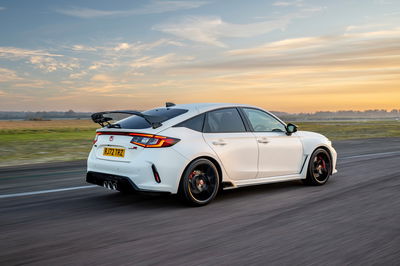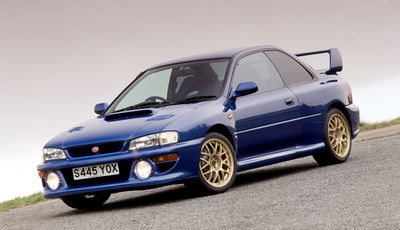10 Of The Most Powerful Front-Wheel Drive Cars Ever

Recently, we stumbled on the forgotten Peugeot 607 Pescarolo concept from 2002, an ultimately abandoned crack at building an M5-rivalling super saloon that would have packed over 400bhp from a twin-turbo V6 shared with a Le Mans Prototype… and front-wheel drive.
Had it come to fruition, we’re fairly sure it would have been the most powerful front-drive production car ever. And also a bit of a mess to drive. See, front-wheel drive has many advantages, but mostly fairly boring, practical ones. Once you start to send lots of power through the wheels that also have to handle steering, things can start to get a bit… chaotic.
Nevertheless, plenty have given it a go, and proven that a front-wheel drive performance car can be just as fun and effective as a rear-drive one. Of course, there are plenty that aren’t so well-judged either.
We’ve put together a list of 10 of the most powerful front-wheel drive production cars ever to torque-steer their way up and down the planet’s roads, and you might be surprised to find that it’s not all just big-power hot hatches. We’ve kept it to one car per brand, otherwise, this list would just be various Honda Civics, Ford Focuses and inexplicably front-wheel drive American V8s. We've limited it to OEM-spec cars too – so unfortunately, there’ll be none of the madness of Autodelta’s 328bhp 3.7-litre Alfa 147 GTA.
10. Dodge Caliber SRT-4 - 285bhp

If you’re in America, you probably don’t remember the Dodge Caliber very fondly, and if you’re in Europe, you probably don’t remember it at all, even though this early and frankly woeful effort to capitalise on the emerging crossover trend was sold here.
What we didn’t get in Europe was the performance version. No, really. Dodge stuffed a turbocharged 2.4-litre four-pot under the snouty new bonnet to create the SRT-4 (yep, with that branding, they wanted us to believe this was in some way linked to the thumping V10 Viper). It was quick enough – nobody seems to be able to agree on a 0-60mph time, but something around six seconds is the ballpark, and it would hit 155mph – but by all accounts, it was complete rubbish to drive. America, you can keep this one.
9. Renault Megane RS 300 - 296bhp

Before the Renaultsport brand was folded into Alpine and the Megane became a fully electric car, Renault turned out some properly epic hot versions of its family hatch. The short-lived third-generation car never quite delivered the magic that versions of the big-bummed original or swoopy second iteration did, but it did end up as the most powerful of the lot.
It started out with 276bhp, but this was later upped to 296bhp in the 300 version (that name a reference to the power output in PS). This came from a 1.8-litre turbocharged four-pot – the same one fitted to the Alpine A110 – and in Trophy guise, got some serious hardware: a bespoke suspension setup, lightweight brakes, forged wheels, and an all-important limited-slip differential. It was good for 0-62mph in 5.7 seconds and a 162mph top speed.
8. Cadillac Seville STS - 300bhp

The Cadillac Seville name has popped up on plenty of cars over the years, from the sublime (the befinned 1950s original) to the ridiculous (the early ’80s version with its eye-ruiningly ugly ‘bustle back’ rear). Its last appearance (so far), though, was on a boxy and not totally unattractive mid-sized saloon made from 1997 to 2003.
It used GM’s 4.6-litre Northstar V8 – an engine famed for its supposed ability to run for 100 miles without any coolant – which pushed 300bhp to the front wheels in top STS trim. That meant 0-60mph in 6.4 seconds and a 149mph top speed. The Seville STS also spearheaded one of several unsuccessful attempts from Cadillac to break into the European market and was briefly sold in the UK with right-hand drive.
7. Mini JCW GP F56 - 302bhp

The third version of Mini’s series of hardcore, two-seater GP hatches had so much promise. A wider track, accommodated by some entirely ridiculous arch extensions made from carbon fibre left over from the BMW i3’s construction; a totally stripped-out interior; firmed-up suspension; and a mighty 303bhp from its 2.0-litre turbo four, making it good for 62mph in 5.2 seconds and a 165mph top speed.
Unfortunately, in building it, Mini sort of forgot what made people like Minis. It was automatic only and sacrificed the inherent sense of fun and cheekiness of a standard JCW in favour of chasing lap times. A bit of a swing and a miss from Mini, but still the most powerful version ever of the regular Mini hatch.
6. Chevrolet Monte Carlo SS - 303bhp

The Chevrolet Monte Carlo started out life as a muscular rear-drive coupe, and its 1980s guise was one of the cars of choice of the lowrider subculture. By the time the 2000s rolled around, though, it had devolved into a frumpy-looking front-wheel drive coupe with some extremely odd proportions.
At the top of the range was the SS version which, from 2006, packed a 5.3-litre V8 that sent 303bhp through the front wheels. All of this had to be handled by a slushy four-speed automatic, and while it would theoretically hit 60mph in a healthy six-ish seconds, it was very much a cruiser rather than an out-and-out sports car. If the Monte Carlo’s odd looks were too much for you, the same engine was available in the closely related Chevy Impala, Buick LaCrosse and – arguably the best of the bunch – the Pontiac Grand Prix.
5. Volkswagen Golf GTI Clubsport S - 306bhp

If you could only drive one car for the rest of your life, you could do much, much worse than the Mk7 VW Golf GTI. Fast, fun, efficient, reliable, well built, practical, and one of the last VWs before the brand’s interior design went a bit off the rails.
By ditching the rear seats, throwing out some sound deadening and firming up the suspension, 2016’s Clubsport S throws quite a lot of that universal appeal out of the window, but it did make the GTI more entertaining to drive than ever. It also saw power from its 2.0-litre turbo four turned up to a Golf R-matching 306bhp – but unlike the R, it was all still going through the front wheels. If the idea of a hatchback with no back seats sounds a bit daft for you, then the same engine in the same state of tune was found in 2018’s SEAT Leon Cupra R – good luck tracking one down, though.
4. Honda Civic Type R FL5 - 325bhp

The first couple of versions of the Honda Civic Type R were all about high-revving VTEC heroics and handling finesse rather than outright power. Ditto for the third-gen FN2 version, minus the bit about handling finesse.
After that, the Type R went on hiatus for a few years, and when it returned in 2015, it brought 306 turbocharged bhp to the table. That would increase to 316bhp for 2017’s FK8, and jump up again to 325bhp for the current FL5 version, which will crack 62mph in 5.4 seconds and top out somewhere around 170mph. Better yet, it still handles fantastically, thanks to lots of suspension trickery and a very well-calibrated limited-slip diff. It may be £50k, but it’s a beautiful demonstration of how to build an incredible front-drive performance car.
3. Ford Focus RS500 - 345bhp

The standard version of the second-gen Ford Focus RS didn’t exactly mess around with 301bhp from its 2.5-litre turbocharged five-cylinder, but it was the limited-edition RS500 from 2010 that pushed the limit of what we thought was possible at the time.
A new air filter, intercooler and exhaust, and a reflashed ECU all contributed to a mighty 345bhp being sent to the front wheels. Despite all of this, the RS500 reportedly wasn’t too much of a pig to drive – no more than the rather excitable standard car, anyway. Just 500 were made (natch), all finished in a rather stealthy matt black. They’re hugely coveted these days – in August 2024, one sold for £88,000 at auction – but Ford tuning specialist Mountune will take a standard RS to an equivalent power level and beyond for a lot less.
2. Lincoln MKZ 3.0T

Seven years after the RS500, though, Ford quietly broke its own record for front-wheel drive power, via its North American luxury sub-brand, Lincoln. The Lincoln MKZ is an utterly forgettable mid-size saloon (sorry, sedan), which, as part of a facelift for its second generation in 2017, received a 3.0-litre twin-turbocharged EcoBoost V6.
In its top form, this engine made 400bhp, which went to all four wheels, but there was also a front-wheel drive version with a detuned 350bhp iteration of the engine. Why? Beats us. It seems to have quite quickly been forgotten – performance figures are hard to pin down, and it was only on sale briefly before the MKZ was discontinued in 2020. By our reckoning, though, it’s the second-most powerful front-wheel drive production car ever, bested only by…
1. Oldsmobile Toronado - 400bhp

In the 1960s, General Motors decided that the upcoming flagship car for its Oldsmobile brand, the Toronado, should have as roomy an interior as possible. For inspiration, it looked to the likes of the Mini and Renault 4, and how they used a front-drive layout to maximise packaging efficiency. Thing is, they were little runarounds, and the Eldorado was a V8-powered coupe as long as the average widebody airliner.
Nonetheless, GM pushed on (much like the car would in corners), and the Toronado arrived for the 1966 model year with a 7.0-litre, 385bhp V8 driving its front wheels. If that wasn’t muscular enough, 1968 saw it replaced by a 7.5-litre mill that pushed some 400bhp to the front axle. We can’t imagine the effect this had on handling, and luckily we don’t need to, because long-running US magazine Car & Driver neatly summed it up when it tested the Toronado in 1968: “We think a giant, 400-hp, two-and-a-half ton Mini is a gas, but have some reservations about recommending it to citizens with cardiac conditions.”















Comments
No comments found.